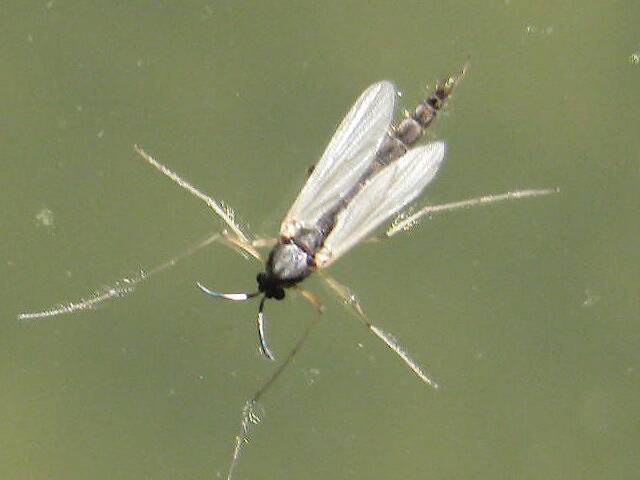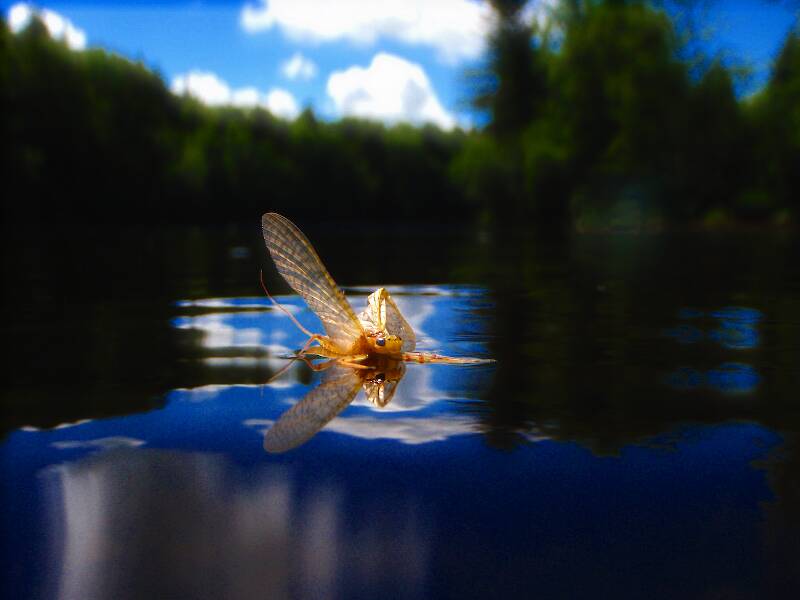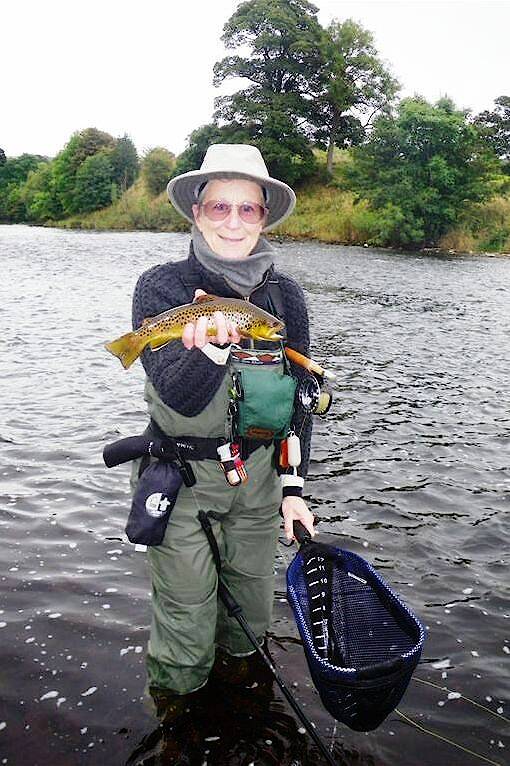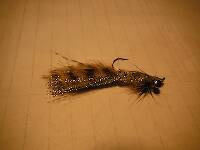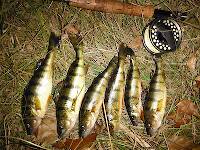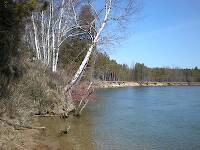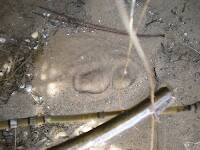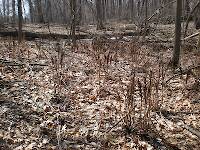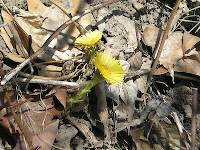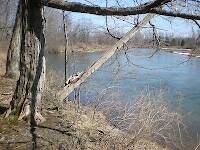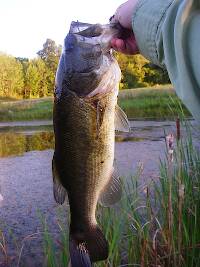
Salmonflies
Pteronarcys californica
The giant Salmonflies of the Western mountains are legendary for their proclivity to elicit consistent dry-fly action and ferocious strikes.
Featured on the forum

This specimen resembled several others of around the same size and perhaps the same species, which were pretty common in my February sample from the upper Yakima. Unfortunately, I misplaced the specimen before I could get it under a microscope for a definitive ID.

Troutnut is a project started in 2003 by salmonid ecologist Jason "Troutnut" Neuswanger to help anglers and
fly tyers unabashedly embrace the entomological side of the sport. Learn more about Troutnut or
support the project for an enhanced experience here.
Trowpa on Dec 6, 2008December 6th, 2008, 4:38 pm EST
Ok - over the past couple winters I've completely fell in love with winter fishing. Its so much more peaceful, usually have the stream to myself, and the fish are more cooperative than i though they'd be.
I've got things down with gear and clothing so i'm very comfy in the cold. However my biggest frustration has been the ice buildup in the guides. I'm constantly picking ice out of them.
I've herad there are some chemicals that some people use..but i don't know of the safety of them for the stream or how long they stay effective.
Anyone have any particular strategy for the ice? or do you just deal?
I've got things down with gear and clothing so i'm very comfy in the cold. However my biggest frustration has been the ice buildup in the guides. I'm constantly picking ice out of them.
I've herad there are some chemicals that some people use..but i don't know of the safety of them for the stream or how long they stay effective.
Anyone have any particular strategy for the ice? or do you just deal?
-Steve
Troutnut on Dec 6, 2008December 6th, 2008, 4:56 pm EST
It's kind of counter-intuitive, but sticking your rod (or at least the guides) underwater can help de-ice them, especially if you're in relatively warm spring-fed water.
Jason Neuswanger, Ph.D.
Troutnut and salmonid ecologist
Troutnut and salmonid ecologist
Martinlf on Dec 7, 2008December 7th, 2008, 3:52 am EST
I've heard chapstick can help. After several icy days I bought some last winter and put it in my vest, but didn't get a chance to use it. I probably will in the new year. I'd think it's no more environmentally unfriendly than many floatants, and that very little of it will end up in the water anyway.
"He spread them a yard and a half. 'And every one that got away is this big.'"
--Fred Chappell
--Fred Chappell
Trtklr on Dec 7, 2008December 7th, 2008, 4:05 am EST
"loon outdoors stanley's ice off paste" apply liberally to guides. I don't know about fly fishing with this, works for spin casting. do you mainly nymph in the winter steve?
I have seen nothing more beautiful than the sunrise on a cold stream.
Falsifly on Dec 7, 2008December 7th, 2008, 5:43 am EST
Steve, I have spent countless hours fly fishing in below freezing temps. I’ve tried the pastes and was disappointed in the results. I find dipping the eyes under water is effective, but that too is dependant on temperature, obviously. Anything you can do to minimize the stripping in or retrieving of line helps. When fishing in freezing conditions I try to use a different technique when possible. I use a fixed amount of line on the water mending as necessary and lifting the rod tip to control slack, retrieving little if any line. Also, aggressive false casting can help to shed water but this can create problems if you are using weight. Most of the water I fish requires added weight to get the fly down quick and deep, and to remain along the bottom. I generally tie in about eighteen inches of tippet and place split shot just above the knot to keep it from sliding down. Anyway, I have resolved to removing ice from the eyes with thumb and index finger and just deal with it.
Falsifly
When asked what I just caught that monster on I showed him. He put on his magnifiers and said, "I can't believe they can see that."
When asked what I just caught that monster on I showed him. He put on his magnifiers and said, "I can't believe they can see that."
Trowpa on Dec 7, 2008December 7th, 2008, 6:21 am EST
Thanks everyone.
Trtklr - yes, i'm pretty much exclusively nymphing in the winter.
I just got back from fishing - and i tried just dipping the rod in the water - such a simple thing, why didn't i think if it? Thanks Jason! It is much easier than picking out with my fingers...but i find i have to do it pretty often. I also have been using fixed line length more often (as mentioned above).
Anyway today actually the ice was the least of my problems - the wind was the big thing. Had some pretty strong gusty wind 20-30mph maybe today and simply casting the 4wt let alone getting a good drift was tough at times.
2 1/2 hrs and was only able to get one fish, but it was satisfying because the ice and the wind made me work for it!
Trtklr - yes, i'm pretty much exclusively nymphing in the winter.
I just got back from fishing - and i tried just dipping the rod in the water - such a simple thing, why didn't i think if it? Thanks Jason! It is much easier than picking out with my fingers...but i find i have to do it pretty often. I also have been using fixed line length more often (as mentioned above).
Anyway today actually the ice was the least of my problems - the wind was the big thing. Had some pretty strong gusty wind 20-30mph maybe today and simply casting the 4wt let alone getting a good drift was tough at times.
2 1/2 hrs and was only able to get one fish, but it was satisfying because the ice and the wind made me work for it!
-Steve
Al514 on Dec 7, 2008December 7th, 2008, 10:48 am EST
Recoil Guides are excellent for the ice. They reduce the ice anyway and have full flexibility, so picking the ice off is simple as running your hand or fingers up the rod. When the guides bend, the ice breaks off.
LittleJ on Dec 8, 2008December 8th, 2008, 1:41 am EST
Winter is time to work on your short game. I have little to no problem with ice because my line never actually touches the water.
jeff
jeff
Trowpa on Dec 8, 2008December 8th, 2008, 5:00 am EST
LittleJ - yep that's what i've settled on - mostly the "high sticking" nymphing. Yesterday i was casting more line than i usually due just to try to get some weight out there to combat the wind. What i ended up doing was giving up on the wind and fishing a sheltered spot - that's where i was finally able to get a fish :)
Not only does highsticking/fishing with fixed short length of line help the ice, but it also allows me to wear fingered gloves more often and keep my hands toasty :)
Not only does highsticking/fishing with fixed short length of line help the ice, but it also allows me to wear fingered gloves more often and keep my hands toasty :)
-Steve
LittleJ on Dec 12, 2008December 12th, 2008, 8:12 am EST
I forgot to mention my sales pitch on winter fly lines. If you haven't tried one yet you have to pick up a cortland sylk fly line. Hands down the best cold weather fly line I have ever used. It stays supple in cold weather so you can feel your strikes. I picked up 2 last year mainly for use as a winter line, but I ended up using one my 4wt for drys this summer as well. I was worried that it would collapse and get gummy during the summer heat but it really held up well. It feels about a half size smaller than normal lines so if you fish fast rods you may want to bump up a size.
Jeff
Jeff
Aaron7_8 on Dec 14, 2008December 14th, 2008, 12:39 pm EST
I have a question. As I look out my window today and it is a balmy -8 degrees it reminds me of fishing last winter and late this fall. It wasn't the ice clogging the guides that got to me it was the ice building up on the line while false casting. Does any one have any suggestions or strategies.
CaseyP on Dec 14, 2008December 14th, 2008, 12:47 pm EST
the lady i fished with this afternoon mentioned, "There's something they make to prevent that," but then one of us hooked a fish and we forgot the rest of the conversation. no ice this afternoon--air temp 38, water 48, bright slanting sun, no wind. little flies that must have been BWOs except they seemed awfully pale--what sorts of colors do they come in?
if this is winter fishing, i'm all for it!
if this is winter fishing, i'm all for it!
"You can observe a lot by watching." Yogi Berra
Martinlf on Dec 17, 2008December 17th, 2008, 1:49 pm EST
Hi Casey,
I've been startled by the shades of grey, olive and yellow-green that BWO's come in. And I've heard some are brownish. Some I've found seem near yellow, with just a hint of green, and others are more grey than olive. Part of this seems to be that there are many different bugs called BWOs, and the other part is that the same bug can vary in color, sometimes even in the same stream. Oh, and there's that issue of how long since hatching. Cornutas, for example, come out of the shuck chartreuse, but darken to olive. Always look at the bottom of the bug to see what color the fish sees, and check the color of your dubbing wet--if you believe color makes any difference, that is. There seems to be some disagreement about this, if you can believe it. :)
I've been startled by the shades of grey, olive and yellow-green that BWO's come in. And I've heard some are brownish. Some I've found seem near yellow, with just a hint of green, and others are more grey than olive. Part of this seems to be that there are many different bugs called BWOs, and the other part is that the same bug can vary in color, sometimes even in the same stream. Oh, and there's that issue of how long since hatching. Cornutas, for example, come out of the shuck chartreuse, but darken to olive. Always look at the bottom of the bug to see what color the fish sees, and check the color of your dubbing wet--if you believe color makes any difference, that is. There seems to be some disagreement about this, if you can believe it. :)
"He spread them a yard and a half. 'And every one that got away is this big.'"
--Fred Chappell
--Fred Chappell
JAD on Dec 19, 2008December 19th, 2008, 1:14 am EST
Interesting post, I used to fish the Dorothea hatch on Oil Creek. For a long time we would do well with a chartreuse CDC caddis and never knew why, it took a number of years for the truth to surface. Those trout truly love to eat Cornutas.
John
John
They fasten red (crimson red) wool around a hook, and fix onto the wool two feathers which grow under a cock’s wattles, and which in colour are like wax.
Radcliffe's Fishing from the Earliest Times,
Phishheaduj on Jan 7, 2009January 7th, 2009, 4:43 am EST
i fished for many hours in freezing temps with shark skin line, the roughness of the line actually helps keep guides clear, didn't have a issue any time out, even with heavy stripping from the use of streamers, which are extremely effective in pa an nj in winter fishing, a little well known "secret". also there are deicers made by various manufacturers, they call them deicers but they are ice preventatives. lol if your willing to pay double for the line, i highly recommend it. shooting is unbelievable. loons makes environmental friendly anti-icing, that works very well.
always learning
Quick Reply
Related Discussions
Topic
Replies
Last Reply
2
Oct 31, 2013
by Kschaefer3
by Kschaefer3
1
Apr 11, 2011
by Jmd123
by Jmd123




